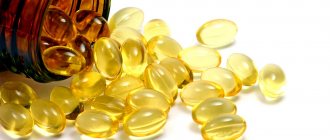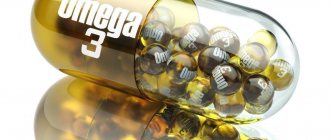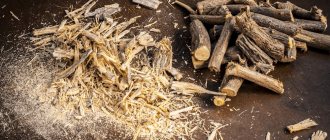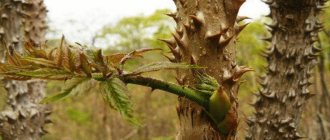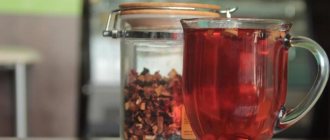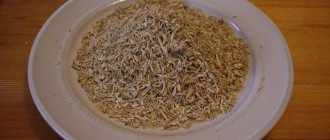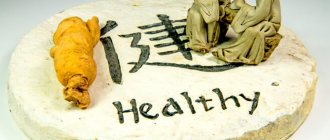Ginseng (“Root of Life”) is a medicinal plant of the Araliaceae family. Used as a general tonic. Ginseng grows in North America and Asia (Korea, Japan, China, Russia, Vietnam). It is believed that drugs based on it prolong the life and youth of the body. They eliminate symptoms of physical and mental fatigue, increase performance, stimulate sexual function, improve appetite, regulate blood pressure, and have a stabilizing effect on the central nervous system.
Botanical description
Content:
- Botanical description
- Chemical composition
- Useful and harmful properties
- "Red ginseng" with honey
- Folk recipes
- Ginseng tincture
- Benefits for hair
- Growing and Reproduction
- Conclusion
Ginseng has a branching, spindle-shaped tap root, 0.7-2.5 cm thick and reaching 25 cm in length. As a rule, large longitudinal or spiral-wrinkled branches extend from it. The “body” of the root is cylindrical with pronounced annular thickenings at the top, forming an apical bud. The leaves are palmately compound, long-petiolate, and converge into a whorl at the top of the stem. The flowers are small, pale green, collected in an umbrella. Visually they resemble stars. The stem is single, hollow inside. Plant height – 30-70 cm.
The fruit is a drupe with two flat seeds, bright red in color. The ripening period is August-September. The seeds are wrinkled, irregularly round in shape with a spout at the base, yellowish-gray in color.
Chemical composition
The underground part of ginseng, the root, is used for medicinal purposes. Preparations based on it have a mild relaxing effect on the human central nervous system. This category of medical products belongs to synergists, which are used instead of phenamine, pyrotoxin, caffeine and camphor as natural stimulants.
Active ingredients of the root:
- xatriols;
- saponins: ginsenosides (panaxosides);
- biologically active polyacetylenes (falcarine triol, panaxinol, panaxidol, panaxytriol, heptadeca-1-ene-4,6-din-3,9-diol, falcarinol);
- polysaccharides (alkali-soluble – up to 10%, water-soluble – up to 38.7%);
- essential oils (sesquiterpenes make up up to 80%);
- fatty acid;
- phytosterols;
- peptides;
- mucus, resins, pectin, organic acids, sucrose;
- vitamins (, , ,), amino acids;
- trace elements: manganese, molybdenum, copper, cobalt, chromium, titanium, zinc, iron.
The amount of minerals in the underground part of the plant increases towards the end of the growing season.
Useful and harmful properties
According to scientific research, it has been established that ginseng roots have adaptogenic, stimulating and tonic effects on the human body. Tinctures, ointments, decoctions, teas, powders, capsules and tablets are prepared from the plant. They improve the function of the nervous, endocrine, digestive and cardiovascular systems, prolong the youth of the body.
Positive influence of the “root of life”:
- Restores strength after grueling physical activity.
- Supports the human nervous system, relieves anxiety, cures neurasthenia, stimulates the breathing of brain cells.
- Accelerates wound healing, relieves inflammation, disinfects, strengthens teeth.
- Improves gas exchange in the respiratory system.
- Increases bile secretion, normalizes carbohydrate metabolism by reducing blood sugar, helps lose weight, reducing the risk of obesity.
- Strengthens hair follicles, improves blood circulation of the scalp, and prevents baldness.
- Activates the activity of the adrenal glands.
- Increases light sensitivity of the eyes.
- Strengthens the immune system and prevents seasonal colds.
Interestingly, ginseng root has a special effect on the body of men. The saponins contained in the plant stimulate the sexual activity of the stronger sex. With regular use of ginseng (for 2 months), sperm motility increases and sexual function improves. As a result, problems with male power gradually disappear. To increase the effectiveness of treatment during therapy, it is recommended to stop drinking coffee, since the drink causes excessive stimulation and excitability.
Despite the uniqueness of the plant, uncontrolled use of tinctures or drugs can cause harm to the body. With prolonged use, biological substances begin to accumulate in organs and tissues, which leads to increased blood pressure, dizziness and nausea. Ginseng shampoos can cause allergies, symptoms reminiscent of seborrhea - dandruff, intense production of sebum.
Contraindications:
- acute respiratory diseases;
- hypertension;
- pregnancy and lactation;
- insomnia;
- hyperfunction of the thyroid gland;
- increased nervous excitability;
- individual intolerance;
- age up to 12 years.
To avoid sleep problems, the “root of life” is taken before lunch, as it has a stimulating effect on the human body.
What are the benefits of ginseng root?
Ginseng root has many medicinal properties that affect various processes in the body. So, why does everyone value this plant so much? It has the following beneficial properties:
- increases appetite;
- has a general strengthening and tonic effect;
- helps in recovery after serious operations and serious illnesses;
- can improve performance;
- normalizes low blood pressure;
- reduces blood sugar and cholesterol levels;
- helps with the functioning of the endocrine glands;
- has a positive effect on the central nervous system;
- increases sexual desire;
- restores sexual function in men.
Beneficial components of ginseng root
Ginseng roots are rich in micro- and macroelements beneficial to the human body. For example, they contain large amounts of potassium, calcium, magnesium and phosphorus. The root also contains copper, cobalt, iron, zinc, chromium and manganese.
In addition, ginseng roots are rich in B vitamins and vitamin C.
"Root of Life" also contains a high concentration of essential oils (especially farnesol), water-soluble polysaccharides (up to 40%) and alkali-soluble polysaccharides (up to 10%).
The main active ingredients contained in ginseng roots, of course, are saponins, xatriols, and BA polyacetylenes.
"Red ginseng" with honey
This is a general tonic. According to experimental data from the Korean National Ginseng Institute, it has been found that it slows down the aging process of the body, increases immune defense, and prevents the development of cancer. In addition, it enhances detoxification, increases energy production in cells, protects against atherosclerosis and diabetes, and stimulates the utilization of oxygen by cells.
A method for preparing a healing potion according to the method of Vladimir Bolibok
Wash fresh ginseng root (1 part), grate and add to heated honey (5 parts). Cook the resulting mass for 1 hour over low heat, cool and transfer to a sterilized glass jar. Store in a dark place. The healing elixir is prepared exclusively in enamel containers, which does not kill its beneficial properties.
Interestingly, heat treatment of raw materials enhances the healing properties of the root due to the conversion of some polysaccharides (starch) into oligosaccharides (caramel). The resulting product is a rich brick shade.
Take 5-10 ml before breakfast, between 8.00 and 11.00. For preventive purposes, “red ginseng” with honey is drunk from October to March, when the body’s immune status decreases.
The therapeutic and prophylactic dose is increased to 15-20 ml per day and distributed 2 times: on an empty stomach in the morning and before lunch.
Indications for use:
- increased mental and physical stress, chronic fatigue;
- prevention of colds in autumn and winter;
- radiation exposure both when radionuclides enter the body and from an external source;
- neuropsychic exhaustion, chronic stress (feelings of anxiety, fear, depression);
- elderly, senile age (for rejuvenation of organs and systems);
- recovery period after surgery, illness and injury;
- chronic intoxication (with alcohol, drug addiction).
“Red ginseng” is a potent remedy that requires strict adherence to prescribed doses. If the drug is abused, the following reactions from the body may occur: neck muscle tension, tachycardia, hair loss, insomnia. If these symptoms appear, stop taking the drug completely or reduce the dosage.
Contraindications for use:
- hypertension;
- pregnancy, age up to 12 years;
- severe neuropsychiatric diseases, seizures;
- encephalopathy (increased intracranial pressure);
- thyrotoxicosis (Graves' disease, hyperfunction of the thyroid gland).
Ginseng with honey is an adaptagen that helps the body save energy and restore strength. Fights fatigue and anemia. Used to activate skin cells: regeneration and improve metabolic processes. Ginseng honey is included in cosmetic soaps, lotions and creams. It helps get rid of wrinkles, pale skin, freckles and eczema.
Contraindications
Remember that no matter how miraculous the ginseng root is, you should consult your doctor before using it!
The use of ginseng should be avoided by people who have an individual intolerance to its components.
Due to the fact that ginseng is a strong stimulant, it can cause headaches, increase blood pressure (for this reason it is not recommended for hypertensive patients), and also cause nausea or vomiting.
Ginseng root in any form should not be consumed by children, as well as pregnant and lactating women.
It is also better not to use ginseng if you suffer from increased nervous excitability, insomnia, infectious or inflammatory diseases, poor blood clotting, or bleeding.
In addition, while taking medications containing ginseng root, it is better to avoid alcohol and caffeine, since ginseng increases the body's sensitivity to other stimulants.
Folk recipes
Ginseng is a stimulant that has a gentle effect on the human body and reveals its reserves. Helps cope with depression, slow down aging, resist infections and diseases of internal organs. Improves mood, increases performance, harmonizes circadian rhythms.
Recipes with ginseng:
- To improve memory, reduce cholesterol levels, improve the functional state of the heart. Fresh ginseng root is pureed in a blender, 15 mg of the resulting mass is mixed with 30 ml of freshly squeezed grape juice. Use 30 drops once a day.
- For skin infections, pain and calluses. To prepare a medicinal paste you will need 30 g of dry crushed ginseng and 50 ml of hot water. Mix the ingredients, leave for 3 hours, then heat in a water bath, stirring regularly, cool. The ointment is applied to the affected areas for a quarter of an hour, after which it is washed off with warm water. Use as needed 2-4 times a day.
- For bronchitis. To speed up the removal of mucus and relieve inflammation in the upper respiratory tract, a decoction is prepared from ginseng roots (30 g) and water (200 ml), which is boiled for 5 minutes. The drink is filtered and drunk warm, 150 ml 3 times a day.
- To improve metabolism and get rid of anemia. Preparation principle: mince ginseng roots (100 g), add warmed honey (900 g). Mix the contents, leave to infuse for four weeks in a dark place, stirring regularly. The course of treatment is 8 weeks. Take 2.5 ml before breakfast.
- To boost immunity. Pour boiling water over the dry root powder, maintaining a ratio of 1:10, wrap the container in a towel, and wait 10 minutes. Take 15 ml of prepared tea 20 minutes before meals 3 times a day for 30 days. After a month, repeat the course of treatment.
- To improve the functioning of the digestive tract and increase efficiency. Ginseng honey extract (5 ml) is added to hot boiled milk (200 ml), the mixture is cooled to 40 degrees and added to the fermented milk starter. Shake the curdled milk and take 200 ml twice a day half an hour before meals.
Extract from ginseng roots is produced in capsules of 0.75 g, 1 g and in the form of tinctures. To fortify the drug, lyophilized royal jelly, vitamins A, , C, , , phosphorus, potassium iodide, zinc and calcium sulfate, and iodine-iron fumarate are added to its composition. The treatment regimen depends on the disease and is prescribed by the attending physician. Preparations with ginseng are used to combat anemia, arrhythmia, arthritis, atherosclerosis, bronchitis, hypotension, headaches, flu, depression, diabetes, toothache, impotence in men, nervous and physical exhaustion, flatulence, calluses, muscle pain and cramps, runny nose and cough, neurasthenia, baldness, stomach upsets, blurred vision, acne.
The miraculous properties of ginseng
Since ancient times, legends have been made about the miraculous properties of ginseng. In our time, modern medicine has been able to prove and explain the healing properties of the “divine herb”.
Has a calming effect
Scientists have found that ginseng has a calming effect, making it recommended for use in cases of depression, stress, neurotic conditions, increased irritability, mental stress, and nervous excitability.
Lowers blood sugar levels
Ginseng is also beneficial for diabetics due to its ability to lower blood sugar levels. In addition, thanks to the substances contained in ginseng root, its regular use helps normalize blood pressure, which is especially important for hypotension.
Has antioxidant and anti-inflammatory properties
These are some of the most important properties of ginseng that have been proven by scientific research.
The study by Korean scientists involved 18 young athletes who took 2 g of Korean red ginseng extract three times a day for seven days. The subjects were then tested for certain inflammatory markers. These numbers were significantly lower than those in the placebo group, and the effect lasted up to 72 hours.1
Another, more extensive, study conducted in 2014 involved seventy-one women, all of whom were postmenopausal. Subjects took 3 grams of red ginseng or a placebo daily for 12 weeks. The scientists then studied antioxidant activity and markers of oxidative stress and concluded that red ginseng may reduce oxidative stress by increasing the function of antioxidant enzymes.2
Ginseng will restore male strength
Experiments have shown that after two months of use, more than 80% of men note an increase in their sexual activity. All this thanks to saponin - a substance that can restore a man to his former sexual strength, as well as make sperm more active.
Ginseng acts here as a stimulant - it, of course, cannot increase the duration of sexual intercourse, but it is quite capable of strengthening an erection and having a beneficial effect on potency in general. A 2007 study by Brazilian scientists found that ginseng may be a useful alternative for treating erectile dysfunction in men.3
It is recommended to use ginseng root for problems with premature ejaculation, as well as for impotence.
Improves memory and mood
Ginseng may improve brain functions such as memory and mood.4 In addition, some studies have shown that the drug has a positive effect on brain function in people with Alzheimer's disease.5 However, more research is still needed in this area.
Ginseng root and female beauty
Ginseng root extract and its essential oils are widely used in cosmetology. It's no secret that ginseng has the amazing ability to stimulate the restoration (regeneration) of the skin, as well as accelerate hair growth. Due to its bactericidal effect, ginseng is often added to acne-fighting products. Ginseng is also added to anti-aging cosmetics - it helps smooth out fine wrinkles, promotes cell regeneration, enhances microcirculation, improving overall skin health.
In addition, some women use ginseng for weight loss. Ginseng is able to normalize metabolism in the body, so this use is completely justified.
Ginseng tincture
The healing elixir is used to reduce blood glucose and cholesterol levels, improve adrenal function, and relieve symptoms of drowsiness. Ginseng root infused with alcohol is indicated for overexertion, neurasthenic and asthenic syndromes, exhaustion of the body, insufficient erection, vegetative-vascular dystonia, reduced immunity, diabetes mellitus and arterial hypotension.
Direction of use: 30-50 drops 40 minutes before meals three times a day (can be diluted in water or juice). The maximum safe daily dose for an adult is 200 drops. The tincture has a stimulating effect on the human body, which is why it should not be taken immediately before bed. While consuming ginseng, it is strictly forbidden to drink alcoholic beverages.
In case of an overdose of the drug, adverse reactions are observed: body temperature rises, skin rashes appear, dizziness, nausea, vomiting, insomnia, tachycardia, and a sharp jump in blood pressure occur.
Contraindications for use: hypertension, increased excitability, allergies, pregnancy, lactation, age under 16 years, insomnia.
Recipes for making tincture:
- From dry root. Pour ginseng powder (30 g) with vodka (1 l), leave for 4 weeks, strain. Take for 2.5 months, repeat the course after 30 days.
- From fresh root. Rinse the raw materials thoroughly, remove soil, dry, then puree in a blender. Pour the ginseng root pulp (100 g) with vodka (1 l), leave for 1 month, periodically shaking the mixture, and strain. Use for 30 days, after a ten-day break, repeat the course.
To prepare the tincture, instead of vodka, you can use 40% or 50% alcohol. Store the healing elixir in a glass jar in a dark place, tightly closed.
The tincture is recommended for women at the stage of planning pregnancy, as it stimulates blood circulation in the pelvis. At the same time, immediately after conception the product is contraindicated for use.
Interestingly, ginseng tincture contains saponin, which stimulates reproductive function in men. It serves as a powerful libido stimulant, dilates blood vessels, improves sperm quality, promotes erection, and stimulates the functioning of the sex glands. The tincture is used to enhance potency, relieve fatigue and signs of overwork. It has a beneficial effect on the organs of the endocrine system.
Before treatment you should consult your doctor.
How to take ginseng?
It all depends on which form of release is most optimal for you. Ginseng is sold in capsules, tablets, powder, tincture and even the whole rhizome.
The most convenient form of release is capsules, since they allow you not to waste time on selecting the correct dosage and fit perfectly into the crazy rhythm of modern life. It is enough just to drink one capsule daily - preferably in the morning.
If you have fresh ginseng root, you can prepare a healthy tincture yourself. To do this, you need to wash it well and dry it. Grind the dry root into powder and add vodka at the rate of 60 grams of powder per two liters of vodka. The resulting liquid must be infused for four weeks, stirring occasionally. After a four-week period, the tincture should be filtered and taken daily in the morning, 0.5 teaspoon for a month and a half. At the end of the course, a month-long break is taken, after which the course can be repeated.
Benefits for hair
Masks, tinctures and decoctions based on ginseng (when used externally) stimulate the growth of new hairs, get rid of dead skin scales and sebum residues, improve blood flow to the follicles and help remove dandruff. For medicinal purposes, only the root of the plant is used, which is cut off in the seventh year of life. It is at this “age” that it accumulates beneficial B vitamins, tannins, ascorbic acid, pectin, fatty acids, resins, sulfur and phosphorus, which have a positive effect on the condition of the hair.
Benefits for hair:
- increases the elasticity of the scalp, nourishes it and protects it from dehydration;
- stops hair loss;
- eliminates dandruff;
- strengthens hair follicles;
- adds natural shine to strands, making them smooth and manageable.
A distinctive feature of hair care products with ginseng is their rapid results. A positive effect can be noticed after the first use. Ginseng tincture can be purchased at a pharmacy or made independently. It is rubbed into the roots at least 2 times a week. After applying the product to the hair, put a plastic bag on the head, wrap it in a warm towel, and wait 30 minutes. The tincture is washed off or left until completely absorbed.
Cooking variations:
- From fresh ginseng root. Wash the raw materials, dry them, grind them and add alcohol, observing the ratio of 1: 10. Leave for a month in a dark place, strain before use.
- From dry ginseng root. To prepare, just pour the powder (30 g) with vodka (1 l), leave to infuse for 3 weeks, strain.
- Alcohol-free tincture. Indicated for use by people with sensitive scalp. To prepare the product, ginseng root powder (30 g) is poured with boiling water (250 ml) and left to steep for 1 hour. The tincture is cooled to room temperature and applied to the hair.
- With grape juice. Alcohol tincture of ginseng (10 drops) is mixed with grape juice (100 ml). Rub the resulting product into the scalp, leave for 40 minutes, rinse with water.
It is recommended to add ginseng tincture to finished cosmetic products (masks, shampoos, balms) to enhance their effect.
Hair masks:
- For shine of hair. Ingredients: linden honey (25ml), boiled water (200 ml), crushed ginseng root (30 g). Mix all ingredients and leave for 1 hour. Keep the mask on your hair for at least 30 minutes, rinse off.
- To nourish curls. Ingredients: cream (10 ml), chopped ginseng root (10 g), chicken yolk – 1 pc. Mix the components, apply to the root zone of the hair, then distribute along the entire length. After 1.5 hours, wash off the mask.
- To strengthen strands. Ingredients: castor oil (30 ml), ginseng tincture (15 ml), apple cider vinegar (15 ml), chicken egg yolk – 2 pcs. Combine the components and apply the contents to the entire length of the curls. Leave the mixture on your hair for a maximum of 10 minutes, then rinse with water.
- Against dry hair. Ingredients: applesauce (15 g), banana – ¼ piece, ginseng tincture – 15 ml, orange juice – 60 ml. The components are mixed, kneaded until a homogeneous mass is obtained, applied to damp hair, leave for 35 minutes, rinse with water.
To cleanse the scalp of keratinized scales, homemade peelings based on ginseng are used. They not only remove dandruff and get rid of sebum, but also improve blood flow to the hair follicles and nourish the dermis of the head. To prepare the peeling, you need to mix sea salt with ginseng tincture and shampoo in a ratio of 2: 1: 1. Rub the resulting product into the skin, distribute over the strands, and rinse with water. Use 1-2 times a week. The oilier the hair, the more often you need to carry out a cosmetic procedure.
Growing and Reproduction
The area for ginseng is protected from prevailing winds and open sunlight. It should have a slight slope to drain rain and melt water. It is a shade-tolerant plant with a shallow root system that is vulnerable to drought. For favorable growth, the area with ginseng is kept in a loose, moist state by mulching. Loamy soil with a high humus content and drained sandy loam soil are considered the most favorable. It grows slowly and reproduces by seeds. In the first year of life, it forms one three-lobed leaf. The roots are not dug up for the winter. Intensive growth of the root mass occurs in the third year. It is during this period that ginseng begins to bear fruit. Seeds are collected in the fourth year. From one plant you get up to 40 pieces.
By the end of the fifth year, the height of the plant stem reaches 30-70 cm, depending on growing conditions.
The most common method of growing ginseng is the seedling method. In this case, one- or two-year-old roots with an apical bud are used. The recommended time for planting seedlings is autumn. During this period, the roots have the greatest survival rate. For propagation, plants use exclusively solid, dense shoots, since damaged roots will rot in the soil. The beds are covered for the winter.
Ginseng tolerates frost better than winters with frequent thaws.
Natural organic matter in the form of rotting fallen leaves, bark, and oak sawdust is suitable as a top dressing. At the same time, chemical fertilizers and manure stimulate the growth of shoots, increasing their susceptibility to disease.
Procurement of raw materials
Best materials of the month
- Coronaviruses: SARS-CoV-2 (COVID-19)
- Antibiotics for the prevention and treatment of COVID-19: how effective are they?
- The most common "office" diseases
- Does vodka kill coronavirus?
- How to stay alive on our roads?
Wash the dug up roots, dry them, place them on a wire rack and leave them in a well-ventilated room with a temperature of 15-30 degrees. Turn over once a day to prevent mold from growing. To check the level of drying, the raw material is broken. If, when bent, the roots make a characteristic cracking sound, then the crop is ready for long-term storage.
Price and quality
The price of ginseng varies not only depending on the variety, weight and age, but also on its quality level. The highest quality ginseng is called “heavenly”, slightly less quality is called “earthly”. What follows is simply “good.” Low quality ginseng is called “cut” ginseng.
The ideal plant must meet certain requirements. First of all, the root must weigh more than seventy grams and must not have any pits or holes. In shape it should be similar to the silhouette of a person and be transparent to light.
In mass production, ginseng is usually grown for up to six years, after which it is collected for subsequent sale. It is at this age that the amount of saponins in ginseng reaches its maximum.

